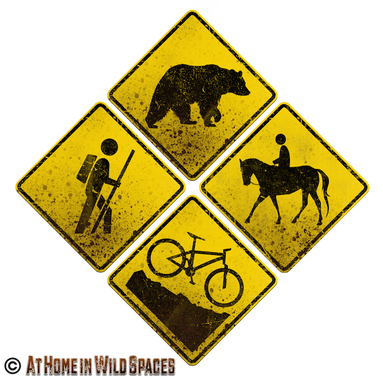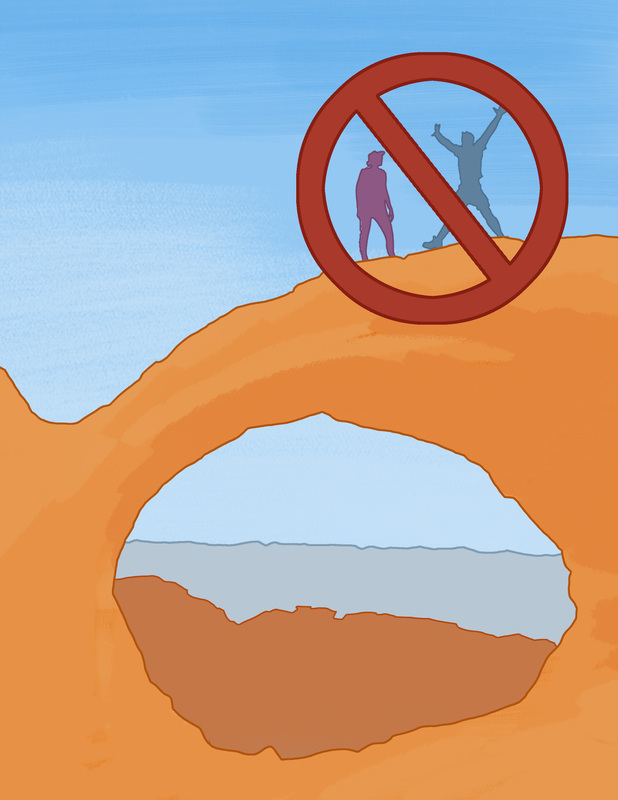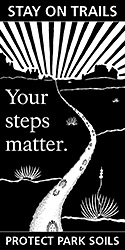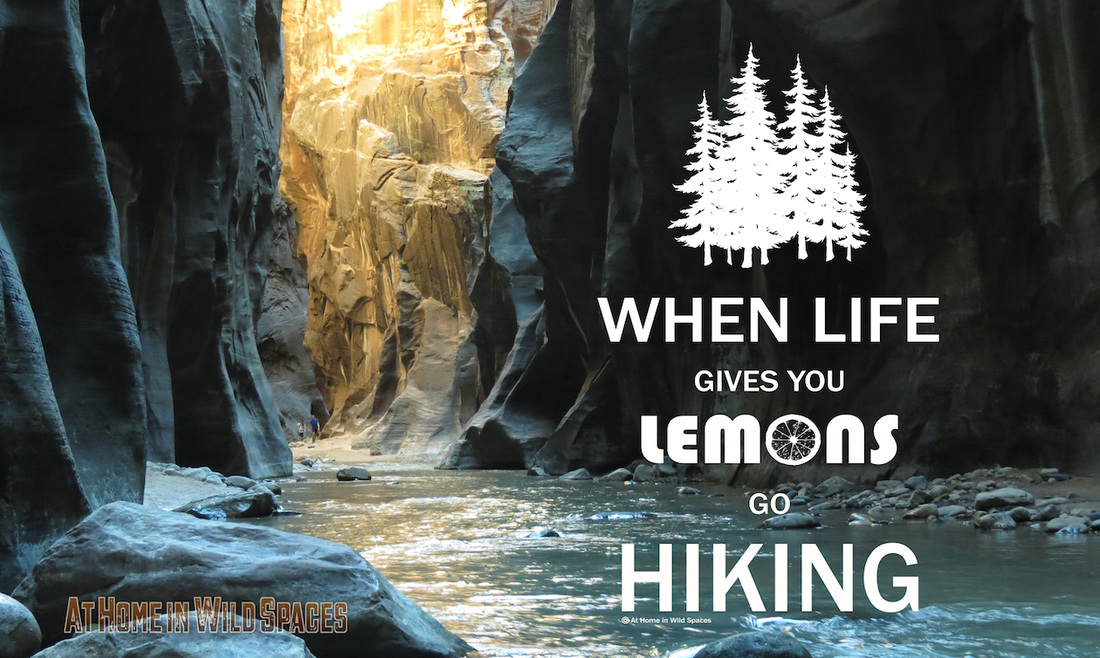Learning to share the trailWith the peak outdoor recreation season soon to reach fever pitch, now seems like a good time to review those practices that will help keep everyone as happy and safe as possible. And ensure that the trails we use remain in top form for what is surely to be a demanding season. the BasicsTo begin, lets get the obvious stuff out of the way. Whether you've heard it once or hundreds of times it, bears repeating -- Leave No Trace. This includes carrying out anything and everything you bring with you. It also means don't leave blatant signs of your presence. Specifically, markings or tags whether on rocks, trees signs or structures. Just don't do it. It detracts from the experience for everyone else and often causes expensive or irreparable damage. Now for some things you may or may not know. Who Yields to Who?Ok, so you're the kind of person who never heads out on the trail without your "awesome badge" and is always courteous to others on the trail. You're wonderful! Treat yourself to something nice. You deserve it. Seriously. But are there rules both written and otherwise that you should respect while on the trail? In a word yes. Let's say you're hiking, biking, riding horseback and you come across someone who is hiking, biking or on horseback - Who should move aside and allow the other to pass? Well here's how it should work: As far as hikers and mountain bikers are concerned; whoever is walking or peddling uphill should be given right of way. Generally speaking, bike riders should yield to hikers. Mountain bikers also should remember, if you cannot clearly see whether the trail ahead is clear, then slow down until you are certain your path is clear of hikers, people on horseback and wildlife. Both hikers and bikers yield to horses, mules, and lamas. If on a steep slope, then step off the trail on the downhill side in order to avoid causing rockslides that might startle the animal(s). Also stay calm and avoid making loud noises or sudden movements which again, might startle the animal(s). Finally, everyone yields to wildlife. Whether encountering a moose, bear, deer, snake, etc... Wild animals have no comprehension of human trail etiquette. Given time wild animals will move off the trail and allow you to carry on. Just make sure to keep your distance. Not only can wild animals be unpredictable and dangerous, but most states have laws prohibiting harassment of wildlife. basic courtesiesEcho...Echo....echo... Listening to your voice echo back from canyon walls can be fun, but remember; there are other people on the trail too. Many who are there to enjoy the natural soundscape, not your hoots and hollers. And, if you must bring your music along, then please USE EARPHONES. That way you can enjoy your music while allowing everyone else to enjoy their day on the trail as well. In general, be aware of the noise you are making and how it can effect others. Avoid shouting and loud whistles unless in need of help. Respect trail limitations. If dogs, biking, and so on are restricted or prohibited on any given trail, be respectful the trail and the people who use it. Find another trail that is better suited for your activity if necessary. Final Considerations.There are a few things that are not necessarily trail "law", but they can make a huge difference. Fore example: "short cuts" particularly on switchbacks. Please, forget the short cut. Slowdown - enjoy yourself. Wandering off trail can cause significant damage to vegetation and accelerate erosion, significantly degrading trail quality. This is important etiquette to follow whatever trail you're on, but even more so for popular, well traveled trails.
Take only pictures. The outdoors are full of beautiful flowers, cool looking rocks and much more. Do everyone a favor and leave everything exactly as you find it (trash being the exception). Granted, unless you're in a national park, there is generally no law prohibiting prohibiting anyone from gathering flowers, rocks and so on. But each year flower meadows are picked clean, rock hunting damages landmarks and unique areas. All this affects the experience available to others who come after you. You may not know, but there are many places which required special protection because souvenir collecting has and can get out of control. Picked flowers soon wither, souvenir rocks are quickly forgotten. We offer you an open invite to value preservation more than collection. There you have it! Now get out there, enjoy yourself and allow others to do the same.
0 Comments
Weather - While the term "bad weather" seems somewhat short sighted, the truth is there are appropriate and inappropriate activities for every brand of weather you might encounter -- especially when outdoors. Pay attention to the forecast. Being caught in a large storm system can be disorientating and dangerous. Arguably the best time to go snowshoeing is after a storm has just dropped a fresh layer of snow. Whenever you venture out, make sure you are aware of possible weather changes and plan accordingly.
Avalanche conditions - Everyone who spends time recreating near mountainous regions in winter should be aware of factors which may contribute to avalanche danger. Know where to go to check for avalanche conditions and advisories for the region you intend to visit. Also, a little education goes a long way. Spend some time learning about avalanche dangers before heading out. It's knowledge that will help you stay safe and may save your life. Here's a quick read to get you started. You'll learn quickly that the best approach is avoiding danger in the first place. Physical Preparation - Snowshoeing takes more effort than hiking. The level of difficulty will depend on the depth and consistency of the snow, as well as how steep your chosen route is. Do not attempt any route that you wouldn't be capable of climbing without the snow. Listen to what your body is telling you. Push yourself, but know your limitations. You know what they say, "Going out is optional, coming back is mandatory." Gear - As far as clothing goes: dress in layers. Include a wind/moisture resistant outer layer. While active, your body temperature will fluctuate. You'll want the ability to adapt as your body temperature changes. Sweating can be very dangerous in cold weather, dressing the part will help you stay comfortable and safe. Make sure to bring plenty of water and food. You'll loose a lot of water and energy when snowshoeing. As far as snowshoes are concerned -- if you've purchased a pair, you've hopefully done your homework and have selected shoes that are best for you. If you don't own any, go a head and rent or borrow some. Sporting stores can often help you find a suitable pair. Get some experience with a number of models before purchasing some for yourself. Navigation - People get lost. That's the unfortunate but preventable reality. Even if you are familiar with the area, it's still possible to loose your way, especially in winter. Bring and know how to use a map and compass. This is even more important if you decide to go off trail. Snow can greatly alter even the most familiar landscape. Knowing how to use a map and compass can ensure you're able to find your way back even if caught in heavy snowfall. Hidden obstacles - Finally, snow can hide potential hazards. When snowshoeing near a river, gorge, cliff etc... It's important to be aware of hidden potentially dangerous obstacles. As a general rule do not approach the edge of any drop-off or river bank. Also bring some ski poles or walking stick so that you can probe any area you are not sure about. But even when probing with a pole, submerged layers of hardened snow and ice can be misleading. Be cautious. The outdoors offer incredible opportunities in any season, just make sure you are prepared. You are responsible for your own safety. Remember: If you're not being safe and having fun, then your not doing it right.
some of the more popular trails. That's not to suggest that you should strike trails like Angels Landing and Half Dome from your bucket list. But often times there are amazing hikes that don't get nearly as much publicity as the paths [more] traveled. Making time for the path less traveled can as the poem claims, "make all the difference". Take the Devil's Garden primitive trail in Arches National Park for example. This some what more challenging trail is not as popular as the hike to Delicate Arch or "Main" Devil's Garden trail, but it's perhaps one of the best hiking experiences within the park. The primitive trail offers a number of lesser known arches, a better opportunity for solitude, and an incredible sandstone playground that most visitors will never see. What's particularly nice about the "primitive" trail is that it can easily be combined with the more popular "main" trail and include a visit to Landscape Arch, considered the largest natural arch in the world, as well as other popular arches, while still enjoying a unique and less trammeled section of Devil's Garden. Together there are more than seven miles of trails through the world class sandstone wilderness called Devil's Garden. A few things to know before you go 1. The primitive trail is considered "strenuous" by the national park service, and includes a number of obstacles which require sure footing a bit of climbing, and occasionally wading through water. 2. The [time] less traveled may be even more important than taking the path less traveled. If possible, align your visit with the off season or weekdays. Avoid holidays as well as spring and fall breaks. Arches in particular can become very crowded. If these times are not compatible with your schedule, then try hiking early. The big crowds won't be up until later.
For more from At Home in Wild Spaces click below!
Make time to get outside. Have fun. Enjoy the coming year with family and friends -- and reserve some quiet time for meditation and introspection. Perhaps to get you started; here's one of our favorite videos. It contains many scenes from our Wild Spaces travels as well as a song that has come to mean a great deal to us.
Happy New Year!!!!!!! Landscape arch is an incredible 290 ft long which would have been impressive enough by itself, but it is also a mind-bogling 6 ft thin at its narrowest point. It's hard to believe that such a massive and delicate stone structure could be suspended over such a great distance. In fact, in 1991 a 76ft chuck fell from Landscape Arch and reduced it's delicate crest from 8ft thick to its current 6ft. Eventually, time and erosion will win out and Landscape Arch will collapse and be little more than boulders and memories. Whether Landscape Arch's remaining time is measured in months, years, centuries or millennia is impossible to know, but while it stands it will remain a truly spectacular natural wonder. If you want to see Landscape Arch in person (we highly recommend it), then make plans to travel to Arches National Park in Utah. This incredible landscape is home to more than 2000 natural arches. The highest concentration of such arches in the world. You'll find Landscape Arch less than a mile along the Devil's Garden trail. This portion of the Devil's Garden is accessible for all skill levels and features a number of other incredible arches and sandstone formations.
Want more from At Home in Wild Spaces? Click on the links below.Before Yellowstone was Yellowstone, it was called Wonderland. The stories of steaming earth, filled with strange spouting wells and painted pools sounded so fantastical to many 19th century americans that it reminded them of a popular novel of the time, Alice's Adventures in Wonderland.
Just like Alice and her travels in Wonderland many visitors may ask themselves, "Which path should I take?". "Well that all depends on where you want to go". There are paths a plenty in Yellowstone with countless little treasures to discover along the way. Take Mystic Falls for example. This beautiful cascade is only a short introductory hike into Yellowstone's back-country. Watch the video for more information. It's a perfect hike for just about any skill level, and a gateway to even more wonders. Just remember Yellowstone is bear country. Be prepared. Know how to handle bear encounters, make noise when hiking. Travel in groups and carry bear spray in a very accessible location. Make sure to stay tuned to At Home in Wild Spaces for more featured locations and travel tips, including bear safety. And check out the rest of our website. There's tons here for any lover of Wild Spaces.
to decorate their walls and patient's rooms with photographs and paintings of natural scenes in order to facilitate healing. But what of the rest of us who aren't currently recovering in a hospital? Are we in need of healing? -- Of course we are. Depression and anxiety are unfortunately on the rise in our modern world. Some have contributed this development to the growing urbanization of our society. More than half of the world's population now lives in cities, and many of us are slowly becoming more and more isolated from the healing power of nature. We've all heard the saying "When Life Gives You Lemons - Make Lemonade". Well, the answer of how to make the lemons of modern life into "healing lemonade" may be as simple as going on a hike, and allow our local, county, State or National nature parks to do what they do best and heal our weary modern bodies and minds -- Even in the colder months. Just make sure to wear a jacket and start small. And check out our NEWLY LISTED, "When life gives you Lemons..." T-shirts by clicking the link below! References:
http://news.stanford.edu/news/2015/june/hiking-mental-health-063015.html http://www.citizen-times.com/story/news/local/2014/09/14/nature-scenes-can-promote-hospital-patient-healing/15646201/
But it's not all good news. Mortality rates among wild condors remain extremely high for many of the same reasons which led to their near extinction in the 20th century. Loss of habitat, diminished food sources, lead poisoning, trash ingestion and poaching continue to frustrate condor restoration efforts. They remain one of the rarest animals in the world. So rare, that they are one of relatively few species where each and every individual is numbered, and tagged. Against the odds condors have come back from the brink of extinction, but they are far from in the clear. Condors are still hugely dependent on captive breeding programs and continuing conservation efforts. But there is hope that with greater awareness and continuing efforts to preserve and restore these birds to what is left of their historic range, that condors may once again soar through our skies on their 10ft wings. Condors remind us that it is possible to bring a species back from the brink. But it requires continual effort and dedication. We've been fortunate to see four wild condors in our Wild Spaces travels, and each time it has been a huge thrill. Check out the stunning footage we shot of these massive birds in Zion and Grand Canyon National Parks. And make sure to check out our store for our new Condor T-Shirts!
References:
http://www.nps.gov/grca/learn/nature/condor-re-introduction.htm http://www.fws.gov/uploadedFiles/Region_8/NWRS/Zone_1/Hopper_Mountain_Complex/Hopper_Mountain/Sections/News/News_Items/PDFs/_California%20Condor%20Five%20Year%20Review_2013%20Final%20Published.pdf http://www.defenders.org/california-condor/basic-facts Today as part two of our on-going scaled comparison series where we highlight two structures; one wonder of nature and one man-made structure. Today, we're highlighting two icons of North America: The Statue of Liberty (305ft tall) in New York harbor and Rainbow Bridge (290ft tall) located in the desert canyon lands of Southern Utah along the shores of modern day Lake Powell.
One serves as an icon of freedom and liberty to a nation comprised mostly of relative new comers, the other an icon of natural beauty, and a sacred site to a people with ancient and deep spiritual ties to the land. Together they represent a diverse set of ideals and history which sometimes clash. We invite you to consider the contrasts and compliments of these two iconic locations and share your thoughts with us in the comments section. Anyone who says Summer is over, clearly doesn't know what their talking about. Now is one of the best times of the year to get outdoors. Let your inner Wild Child loose this weekend, and show everyone that summer is only over when we say it is over. Help us keep summer alive all year long, by supporting us on Kickstarter. http://kck.st/1UacC65
|
Wild Spaces
|









 RSS Feed
RSS Feed
